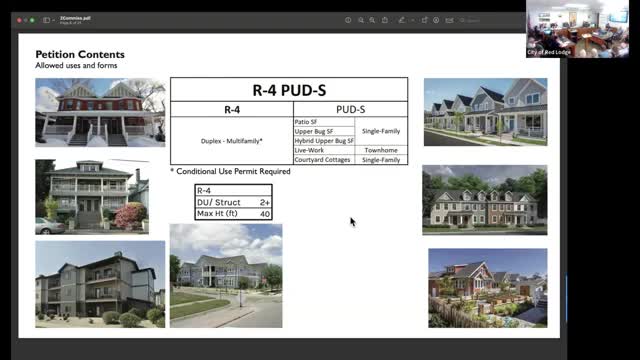Zoning Debate Sparks Controversy Over Housing Density Changes
July 12, 2024 | Red Lodge, Carbon County, Montana

This article was created by AI summarizing key points discussed. AI makes mistakes, so for full details and context, please refer to the video of the full meeting. Please report any errors so we can fix them. Report an error »

In a recent government meeting, officials discussed a proposed zoning change for an 87-acre tract of land in Red Lodge, Montana, currently designated as medium density residential (R-3). The proposal sought to rezone the area to high density residential (R-4), which sparked significant debate among board members regarding the implications for the neighborhood's character and housing diversity.
Several members expressed concerns that the shift to R-4 would disrupt the existing community fabric, creating a \"non-contiguous island\" of high-density housing amidst predominantly R-3 neighborhoods. They emphasized that the current R-3 zoning allows for a variety of housing types, including duplexes and multi-family units, which contribute to a diverse residential environment. The board members highlighted the importance of maintaining a balance between different housing options to support a mixed community of working families and retirees.
Critics of the zoning change pointed out that the proposal lacked sufficient justification and detailed planning, making it difficult to assess potential impacts on the neighborhood. They argued that the R-4 designation was not appropriate given the absence of nearby commercial developments, which are typically associated with higher density zoning. The board ultimately voted to deny the zoning amendment, citing the need for more comprehensive information and a clearer understanding of the proposed development's effects on the community.
The discussion underscored the ongoing challenges local governments face in managing growth and development while preserving the character of established neighborhoods. As the board moves forward, they will continue to seek proposals that align with the community's vision for sustainable and diverse housing options.
Several members expressed concerns that the shift to R-4 would disrupt the existing community fabric, creating a \"non-contiguous island\" of high-density housing amidst predominantly R-3 neighborhoods. They emphasized that the current R-3 zoning allows for a variety of housing types, including duplexes and multi-family units, which contribute to a diverse residential environment. The board members highlighted the importance of maintaining a balance between different housing options to support a mixed community of working families and retirees.
Critics of the zoning change pointed out that the proposal lacked sufficient justification and detailed planning, making it difficult to assess potential impacts on the neighborhood. They argued that the R-4 designation was not appropriate given the absence of nearby commercial developments, which are typically associated with higher density zoning. The board ultimately voted to deny the zoning amendment, citing the need for more comprehensive information and a clearer understanding of the proposed development's effects on the community.
The discussion underscored the ongoing challenges local governments face in managing growth and development while preserving the character of established neighborhoods. As the board moves forward, they will continue to seek proposals that align with the community's vision for sustainable and diverse housing options.
View full meeting
This article is based on a recent meeting—watch the full video and explore the complete transcript for deeper insights into the discussion.
View full meeting
